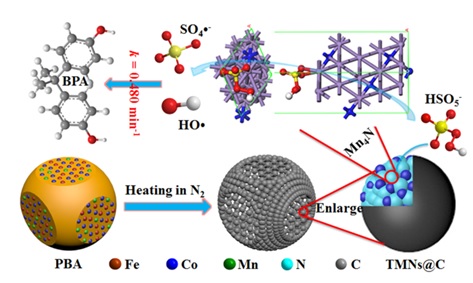The sulfate radical-based Fenton-like reaction was firstly reported by Prof. D. D. Dionysiou's group in 2003. Since then, increasing attention has been attracted for the destruction of recalcitrant contaminants in water. Various kinds of transition metal based materials (oxides, MOFs, bimetals and carbides) have been developed and extensively employed as Fenton-like catalysts. However, until now, few studies on the transition metal nitrides (TMNs) for PMS activation have been reported. In the meantime, the PMS activation process catalyzed by nitrogen coordinated metals has never been well illustrated.
The DICP Research Group (DNL2005) led by Prof. WANG Junhu has made a new progress in the research field of catalyzed peroxymonosulfate (PMS) activation for Fenton-like reaction.
Based on the progresses in Mössbauer spectroscopic studies on Fenton-like reaction mechanism (Catal. Sci. Technol. 2015, 5, 504-514; Appl. Catal. B 2016, 179, 196-205; Catal. Commun. 2016, 77, 32-36), and preparation and exploration of high-performance Fenton-like catalysts (Appl. Catal. B 2016, 181, 788-799; Catal. Sci. Technol. 6, 2016, 7486-7494) as well as the “copolymer-co-morphology” conception proposed for shape-controlled synthesis of Prussian blue analogues and as-derived spinel oxides (Nanoscale 2016, 8, 2333-2342), Prof. WANG’s group newly reported a novel strategy for shape-controlled synthesis of graphene encapsulated TMNs (FexMn6-xCo4-N@C) by topotactic transformation of MnyFe1-y[Co(CN)6]0.67·nH2O in N2 atmosphere. The series of FexMn6-xCo4-N@C have significant implications for the removal of bisphenol A by activation of peroxymonosulfate (PMS).
With the cooperation of Prof. AO Zhimin from Guangdong University of Technology, theoretical calculations were carried out to illustrate that the dramatically reduced adsorption energy and facilitated electron transfer for PMS activation catalyzed by Mn4N are the main contributors for the excellent activity of TMNs@C. Prof. SUN Hongqi from Edith Cowan University in Australia also made great contributions to this work. This work details the first insight into versatile TMNs as a catalyst for sustainable environment remediation by activation of PMS and may pave the way towards the development of high-performance Fenton-like catalysts for PMS activation.

The related result was published in ACS Nano (DOI: 10.1021/acsnano.6b07522). The research work is financially supported by the National Natural Science Foundation of China and the Chinese Academy of Sciences Visiting Professorships for Senior International Scientists. (Text and Imaged by LI Xuning)